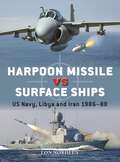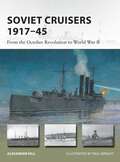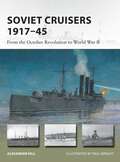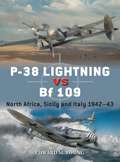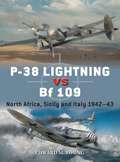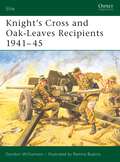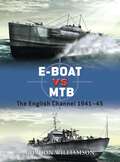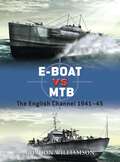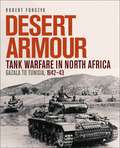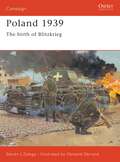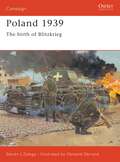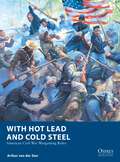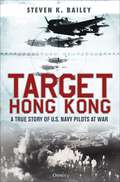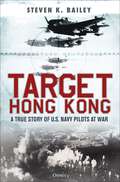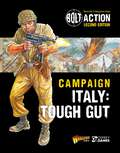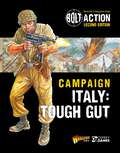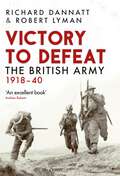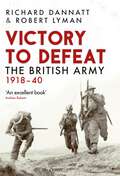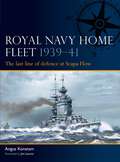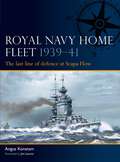- Table View
- List View
Harpoon Missile vs Surface Ships: US Navy, Libya and Iran 1986–88 (Duel #134)
by Lon NordeenAn illustrated study of premier US anti-ship missile, the AGM/RGM-84 Harpoon, and its 1986 and '88 uses against Libyan and Iranian naval vessels.In this study, defence technology expert Lon Nordeen details the role played by the Harpoon missile in two Cold War flare-ups in the 1980s. The Harpoon was the first tactical anti-ship missile developed by the US Navy to provide a counter to the anti-ship missiles exported around the world by the Soviet Union and China. It was deployed on ships, aircraft, submarines and land vehicles and soon became the most widely used anti-ship missile system in the West, with 7,000+ having been produced since 1977, operated by the military forces of more than 30 nations. This exciting book explores the engagements of the Harpoon by the US Navy against its Libyan and Iranian adversaries, using original photographs and specially commissioned artwork to examine the naval systems and weapons employed by both counterparts. Drawing upon interviews with the US Navy A-6 Intruder crews that deployed the AGM084 variant of the Harpoon in 1986 and 1988, the author brings unique insight to his examination of these fascinating duels.
Soviet Cruisers 1917–45: From the October Revolution to World War II (New Vanguard #326)
by Dr Alexander HillA history of the Soviet Navy's cruisers, from the opening shots of the October Revolution through to the combat they saw during World War II.The Soviet Navy of World War II boasted a cruiser fleet that was among the most eclectic to see service. In this book, noted military historian and Soviet specialist Alexander Hill explains the role of cruisers in the Soviet Navy from the dramatic days of the October Revolution of 1917 through to the struggle they fought with Nazi Germany during World War II. Illustrated throughout with rare photos and original artwork, including a cutaway of Aurora, famous for its role in the Bolshevik October Revolution, and with profiles of the key classes, this book outlines the Soviets' development of a cruiser force. Having inherited a number of cruisers from the Imperial Russian Navy, the new Soviet Navy went on to complete two unfinished Tsarist light cruisers during the 1920s. In the late 1930s, the Soviets built their first large warships, the Kirov class, and in 1940 Nazi Germany sold the unfinished heavy cruiser Lützow to the USSR. The final cruiser-sized warship to see action was the former Imperial royal yacht Shtandart, renamed Marti and armed as a minelayer, which was used in the defence of Leningrad. Researched in the main from Russian-language sources, this study explores the cruiser fleet that saw considerable action in World War II, particularly in support of the Red Army.
Soviet Cruisers 1917–45: From the October Revolution to World War II (New Vanguard #326)
by Dr Alexander HillA history of the Soviet Navy's cruisers, from the opening shots of the October Revolution through to the combat they saw during World War II.The Soviet Navy of World War II boasted a cruiser fleet that was among the most eclectic to see service. In this book, noted military historian and Soviet specialist Alexander Hill explains the role of cruisers in the Soviet Navy from the dramatic days of the October Revolution of 1917 through to the struggle they fought with Nazi Germany during World War II. Illustrated throughout with rare photos and original artwork, including a cutaway of Aurora, famous for its role in the Bolshevik October Revolution, and with profiles of the key classes, this book outlines the Soviets' development of a cruiser force. Having inherited a number of cruisers from the Imperial Russian Navy, the new Soviet Navy went on to complete two unfinished Tsarist light cruisers during the 1920s. In the late 1930s, the Soviets built their first large warships, the Kirov class, and in 1940 Nazi Germany sold the unfinished heavy cruiser Lützow to the USSR. The final cruiser-sized warship to see action was the former Imperial royal yacht Shtandart, renamed Marti and armed as a minelayer, which was used in the defence of Leningrad. Researched in the main from Russian-language sources, this study explores the cruiser fleet that saw considerable action in World War II, particularly in support of the Red Army.
P-38 Lightning vs Bf 109: North Africa, Sicily and Italy 1942–43 (Duel #131)
by Edward M. YoungAn exciting account of the aerial battles fought by the USAAF's P38 Lightnings and the Jagdflieger's Bf 109Gs for dominance over North Africa and the Mediterranean.USAAF fighter pilots experienced a baptism of fire when flying the technically advanced but fragile P-38 Lightning over North Africa in the wake of 1942's Operation Torch. Their opponents were battle-hardened jagdflieger of the Jadgwaffe, flying the tried and tested Bf 109 in its very lastest Gustav iteration. Responsible primarily for escorting USAAF bombers attacking Afrika Korps installations in Tunisia, the P-38 units in North Africa had to develop effective tactics to defend the bombers against Luftwaffe fighter attacks. For several months the Lightning squadrons had to also cope with shortages of aircraft and spare parts, steady losses and a lack of replacement pilots. To survive, American aviators had to learn quickly. While it is difficult to definitively attribute victories in air combat, in the air battles over Tunisia and later over Sicily and Italy, the claims made by Lightning pilots were comparable to Luftwaffe claims for P-38s destroyed. Edward M. Young turns his attention to the bitterly fought air war in North Africa and the Mediterranean in 1942–43. Using original archival sources, official records and first-hand accounts from both USAAF and Luftwaffe veterans, as well as newly commissioned artwork and 50 carefully selected photographs from official and personal archives, this book sees two of the most iconic piston-engined fighters of their era pitted head-to-head for control of the skies in a key theatre of World War II.
P-38 Lightning vs Bf 109: North Africa, Sicily and Italy 1942–43 (Duel #131)
by Edward M. YoungAn exciting account of the aerial battles fought by the USAAF's P38 Lightnings and the Jagdflieger's Bf 109Gs for dominance over North Africa and the Mediterranean.USAAF fighter pilots experienced a baptism of fire when flying the technically advanced but fragile P-38 Lightning over North Africa in the wake of 1942's Operation Torch. Their opponents were battle-hardened jagdflieger of the Jadgwaffe, flying the tried and tested Bf 109 in its very lastest Gustav iteration. Responsible primarily for escorting USAAF bombers attacking Afrika Korps installations in Tunisia, the P-38 units in North Africa had to develop effective tactics to defend the bombers against Luftwaffe fighter attacks. For several months the Lightning squadrons had to also cope with shortages of aircraft and spare parts, steady losses and a lack of replacement pilots. To survive, American aviators had to learn quickly. While it is difficult to definitively attribute victories in air combat, in the air battles over Tunisia and later over Sicily and Italy, the claims made by Lightning pilots were comparable to Luftwaffe claims for P-38s destroyed. Edward M. Young turns his attention to the bitterly fought air war in North Africa and the Mediterranean in 1942–43. Using original archival sources, official records and first-hand accounts from both USAAF and Luftwaffe veterans, as well as newly commissioned artwork and 50 carefully selected photographs from official and personal archives, this book sees two of the most iconic piston-engined fighters of their era pitted head-to-head for control of the skies in a key theatre of World War II.
Knight's Cross and Oak-Leaves Recipients 1941–45 (Elite)
by Gordon WilliamsonThe remarkable early successes of the armed forces of the Third Reich prompted the decision that the supreme decoration for personal valour or outstanding leadership – the Knight's Cross of the Iron Cross – was insufficient. To mark further acts of gallantry a new distinction was created in June 1940: the Oak-Leaves clasp. Further decorations in the form of the Swords and, finally, the Diamonds were added. This second title in our series describes and illustrates a selection of recipients of the Knight's Cross and Oak-Leaves between 1941 and early 1944, when the Wehrmacht was engaged on all fronts, as well as at sea and in the air.
Knight's Cross and Oak-Leaves Recipients 1941–45 (Elite)
by Gordon WilliamsonThe remarkable early successes of the armed forces of the Third Reich prompted the decision that the supreme decoration for personal valour or outstanding leadership – the Knight's Cross of the Iron Cross – was insufficient. To mark further acts of gallantry a new distinction was created in June 1940: the Oak-Leaves clasp. Further decorations in the form of the Swords and, finally, the Diamonds were added. This second title in our series describes and illustrates a selection of recipients of the Knight's Cross and Oak-Leaves between 1941 and early 1944, when the Wehrmacht was engaged on all fronts, as well as at sea and in the air.
E-Boat vs MTB: The English Channel 1941–45 (Duel)
by Gordon WilliamsonAn examination of the 'small boat' war between the Germans and the British in the English Channel.During the Second World War, German E-Boats were so active in the English Channel that the narrow stretch of water became known as 'E-Boat Alley'. To counter the threat of these E-Boats, Britain brought its coastal forces to bear – flotillas of small Motor Torpedo and Gun Boats (MTBs and MGBs) and Motor Launches (MLs). As the Germans sought to maintain their supremacy in Channel waters, they continued to develop their E-Boat designs to accommodate more armor and more firepower. Rather than matching the newer E-Boats for armament, the British developed several types to fulfill the varied roles for which the Kriegsmarine were attempting to use the E-Boat. Illustrated with high-quality photographs and battlescene artworks, this book details this developing conflict, examining the evolution of the boats involved, and covering their battles from fights in the Thames Estuary to the build-up for D-Day.
E-Boat vs MTB: The English Channel 1941–45 (Duel)
by Gordon WilliamsonAn examination of the 'small boat' war between the Germans and the British in the English Channel.During the Second World War, German E-Boats were so active in the English Channel that the narrow stretch of water became known as 'E-Boat Alley'. To counter the threat of these E-Boats, Britain brought its coastal forces to bear – flotillas of small Motor Torpedo and Gun Boats (MTBs and MGBs) and Motor Launches (MLs). As the Germans sought to maintain their supremacy in Channel waters, they continued to develop their E-Boat designs to accommodate more armor and more firepower. Rather than matching the newer E-Boats for armament, the British developed several types to fulfill the varied roles for which the Kriegsmarine were attempting to use the E-Boat. Illustrated with high-quality photographs and battlescene artworks, this book details this developing conflict, examining the evolution of the boats involved, and covering their battles from fights in the Thames Estuary to the build-up for D-Day.
Desert Armour: Tank Warfare in North Africa: Gazala to Tunisia, 1942–43
by Robert ForczykRobert Forczyk covers the development of armoured warfare in North Africa from Rommel's Gazala offensive in 1942 through to the end of war in the desert in Tunisia in 1943. The war in the North African desert was pure mechanized warfare, and in many respects the most technologically advanced theatre of World War II. It was also the only theatre where for three years British and Commonwealth, and later US, troops were in constant contact with Axis forces.World War II best-selling author Robert Forczyk explores the second half of the history of the campaign, from the Gazala offensive in May 1942 that drove the British forces all the way back to the Egyptian frontier and led to the fall of Tobruk, through the pivotal battles of El Alamein, and the final Allied victory in Tunisia. He examines the armoured forces, equipment, doctrine, training, logistics and operations employed by both Allied and Axis forces throughout the period, focusing especially on the brigade and regimental level of operations.Fully illustrated throughout with photographs, profile artwork and maps, and featuring tactical-level vignettes and appendices analysing tank data, tank deliveries in-theatre and orders of battle, this book goes back to the sources to provide a new study of armoured warfare in the desert.
Desert Armour: Tank Warfare in North Africa: Gazala to Tunisia, 1942–43
by Robert ForczykRobert Forczyk covers the development of armoured warfare in North Africa from Rommel's Gazala offensive in 1942 through to the end of war in the desert in Tunisia in 1943. The war in the North African desert was pure mechanized warfare, and in many respects the most technologically advanced theatre of World War II. It was also the only theatre where for three years British and Commonwealth, and later US, troops were in constant contact with Axis forces.World War II best-selling author Robert Forczyk explores the second half of the history of the campaign, from the Gazala offensive in May 1942 that drove the British forces all the way back to the Egyptian frontier and led to the fall of Tobruk, through the pivotal battles of El Alamein, and the final Allied victory in Tunisia. He examines the armoured forces, equipment, doctrine, training, logistics and operations employed by both Allied and Axis forces throughout the period, focusing especially on the brigade and regimental level of operations.Fully illustrated throughout with photographs, profile artwork and maps, and featuring tactical-level vignettes and appendices analysing tank data, tank deliveries in-theatre and orders of battle, this book goes back to the sources to provide a new study of armoured warfare in the desert.
Poland 1939: The birth of Blitzkrieg (Campaign)
by Steven J. ZalogaThe German invasion of Poland on 1 September 1939 began World War II in Europe, pitting the newly modernized army of Europe's great industrial power against the much smaller Polish army and introducing the world to a new style of warfare – Blitzkrieg. Panzer divisions spearheaded the German assault with Stuka dive-bombers prowling ahead spreading terror and mayhem. This book demonstrates how the Polish army was not as backward as it is often portrayed and fielded a tank force larger than that of the contemporary US Army. Its stubborn defence did give the Germans some surprises and German casualties were relatively heavy for such a short campaign.
Poland 1939: The birth of Blitzkrieg (Campaign)
by Steven J. ZalogaThe German invasion of Poland on 1 September 1939 began World War II in Europe, pitting the newly modernized army of Europe's great industrial power against the much smaller Polish army and introducing the world to a new style of warfare – Blitzkrieg. Panzer divisions spearheaded the German assault with Stuka dive-bombers prowling ahead spreading terror and mayhem. This book demonstrates how the Polish army was not as backward as it is often portrayed and fielded a tank force larger than that of the contemporary US Army. Its stubborn defence did give the Germans some surprises and German casualties were relatively heavy for such a short campaign.
With Hot Lead and Cold Steel: American Civil War Wargaming Rules (Osprey Wargames #32)
by Arthur van SterA set of wargaming rules for fighting large battles set during the American Civil War.From the First Bull Run to Appomattox Court House, enter one of the defining conflicts of American history. With shot, shell, and sabre, guide the armies of the Blue and the Grey through this first modern war to determine the fate of a nation.With Hot Lead and Cold Steel is a large-scale, mass-battle wargame for recreating the American Civil War. Designed to handle brigade and divisional level engagements while providing a balance between ease of play and period detail, With Hot Lead and Cold Steel is ideal for new gamers and wargaming veterans alike. It contains everything players need to raise armies and craft scenarios, whether based upon historical campaigns and orders of battle or those of their own devising.
With Hot Lead and Cold Steel: American Civil War Wargaming Rules (Osprey Wargames #32)
by Arthur van SterA set of wargaming rules for fighting large battles set during the American Civil War.From the First Bull Run to Appomattox Court House, enter one of the defining conflicts of American history. With shot, shell, and sabre, guide the armies of the Blue and the Grey through this first modern war to determine the fate of a nation.With Hot Lead and Cold Steel is a large-scale, mass-battle wargame for recreating the American Civil War. Designed to handle brigade and divisional level engagements while providing a balance between ease of play and period detail, With Hot Lead and Cold Steel is ideal for new gamers and wargaming veterans alike. It contains everything players need to raise armies and craft scenarios, whether based upon historical campaigns and orders of battle or those of their own devising.
Target Hong Kong: A true story of U.S. Navy pilots at war
by Steven K. BaileyBrought to life by the personal accounts of six Navy pilots and one British POW, this is the history of the U.S. Navy airstrikes on Japanese-held Hong Kong.Commander John Lamade started the war in 1941 a nervous pilot of an antiquated biplane. Just over three years later he was in the cockpit of a cutting-edge Hellcat about to lead a strike force of 80 aircraft through the turbulent skies above the South China Sea. His target: Hong Kong. As a storm of antiaircraft fire darkened the sky, watching from below was POW Ray Jones. For three long years he and his fellow prisoners had endured near starvation conditions in a Japanese internment camp. Did these American aircraft, he wondered, herald freedom? Trawling through historic records, Steven K. Bailey discovered that the story of the U.S. Navy airstrikes on Japanese-held Hong Kong during the final year of World War II had never been told. Operation Gratitude involved nearly 100 U.S. Navy warships and close to a thousand planes. Target Hong Kong brings this massive operation down to a human scale by recounting the air raids through the experiences of seven men whose lives intersected at Hong Kong in January 1945: Commander John D. Lamade, five of his fellow U.S. Navy pilots and the POW Ray Jones. Drawing upon oral histories, diary transcripts, and U.S. Navy documents, this book expertly narrates the intertwined experiences of these servicemen to bring the history to life.
Target Hong Kong: A true story of U.S. Navy pilots at war
by Steven K. BaileyBrought to life by the personal accounts of six Navy pilots and one British POW, this is the history of the U.S. Navy airstrikes on Japanese-held Hong Kong.Commander John Lamade started the war in 1941 a nervous pilot of an antiquated biplane. Just over three years later he was in the cockpit of a cutting-edge Hellcat about to lead a strike force of 80 aircraft through the turbulent skies above the South China Sea. His target: Hong Kong. As a storm of antiaircraft fire darkened the sky, watching from below was POW Ray Jones. For three long years he and his fellow prisoners had endured near starvation conditions in a Japanese internment camp. Did these American aircraft, he wondered, herald freedom? Trawling through historic records, Steven K. Bailey discovered that the story of the U.S. Navy airstrikes on Japanese-held Hong Kong during the final year of World War II had never been told. Operation Gratitude involved nearly 100 U.S. Navy warships and close to a thousand planes. Target Hong Kong brings this massive operation down to a human scale by recounting the air raids through the experiences of seven men whose lives intersected at Hong Kong in January 1945: Commander John D. Lamade, five of his fellow U.S. Navy pilots and the POW Ray Jones. Drawing upon oral histories, diary transcripts, and U.S. Navy documents, this book expertly narrates the intertwined experiences of these servicemen to bring the history to life.
Bolt Action: Campaign: Italy: Tough Gut (Bolt Action)
by Warlord GamesA new supplement for Bolt Action focusing on the later Italian Campaign, following on from Soft Underbelly, adding new units, scenarios, and special rules.In Italy, the fight continues!As the Allies push north up the Italian Peninsula, they have encountered heavy resistance from the Axis and their multitude of fortified and defensive lines, slowing the allied advance to a crawl. The 'soft underbelly' of Europe proved to be false, instead it was a 'tough gut'. This supplement for Bolt Action, and the counterpart to Soft Underbelly, focuses on the battles ranging from the Gustav Line in 1944 all the way to those of the Gothic Line in 1945, with the breakouts at Anzio and Monte Cassino of particular focus. Containing a host of scenarios to refight these famous battles, along with new units, special rules, and Theatre Selectors, this book contains everything players need to bring an end to the war and liberate Italy.
Bolt Action: Campaign: Italy: Tough Gut (Bolt Action)
by Warlord GamesA new supplement for Bolt Action focusing on the later Italian Campaign, following on from Soft Underbelly, adding new units, scenarios, and special rules.In Italy, the fight continues!As the Allies push north up the Italian Peninsula, they have encountered heavy resistance from the Axis and their multitude of fortified and defensive lines, slowing the allied advance to a crawl. The 'soft underbelly' of Europe proved to be false, instead it was a 'tough gut'. This supplement for Bolt Action, and the counterpart to Soft Underbelly, focuses on the battles ranging from the Gustav Line in 1944 all the way to those of the Gothic Line in 1945, with the breakouts at Anzio and Monte Cassino of particular focus. Containing a host of scenarios to refight these famous battles, along with new units, special rules, and Theatre Selectors, this book contains everything players need to bring an end to the war and liberate Italy.
Tokyo 1944–45: The destruction of Imperial Japan's capital (Air Campaign #40)
by Mark LardasThe full history of how the United States targeted and destroyed the Japanese capital from the air, in a ten-month long campaign by the US Army Air Force and the US Navy.In November 1944, the US Army Air Force launched a 111-plane B-29 strike against Tokyo, the first raid since the morale-boosting Doolittle Raid of 1942. From then until August 13, 1945, the United States would attack Tokyo 25 times, 20 from B-29s based in the Marianas and five from US Navy carrier task forces. The campaign included the single deadliest air raid in human history, when around 100,000 people were killed by the firestorm created by the Operation Meetinghouse raid of March 10, 1945. This book, the first to examine the full history of the United States' air campaign against the greatest target in Japan, looks at the USAAF's and US Navy's efforts to use air power to eliminate Tokyo's strategic value to the Empire. It considers how the campaign developed from daylight bombing to firebombing and anti-ship mining, and finally how the target was handed over to the US Navy, whose carrier-based bombers and fighter-bombers continued to strike Tokyo during July and August 1945.Using specially commissioned battlescenes, strategic maps and diagrams, this volume presents a detailed picture of how Tokyo was vanquished from the air.
Tokyo 1944–45: The destruction of Imperial Japan's capital (Air Campaign #40)
by Mark LardasThe full history of how the United States targeted and destroyed the Japanese capital from the air, in a ten-month long campaign by the US Army Air Force and the US Navy.In November 1944, the US Army Air Force launched a 111-plane B-29 strike against Tokyo, the first raid since the morale-boosting Doolittle Raid of 1942. From then until August 13, 1945, the United States would attack Tokyo 25 times, 20 from B-29s based in the Marianas and five from US Navy carrier task forces. The campaign included the single deadliest air raid in human history, when around 100,000 people were killed by the firestorm created by the Operation Meetinghouse raid of March 10, 1945. This book, the first to examine the full history of the United States' air campaign against the greatest target in Japan, looks at the USAAF's and US Navy's efforts to use air power to eliminate Tokyo's strategic value to the Empire. It considers how the campaign developed from daylight bombing to firebombing and anti-ship mining, and finally how the target was handed over to the US Navy, whose carrier-based bombers and fighter-bombers continued to strike Tokyo during July and August 1945.Using specially commissioned battlescenes, strategic maps and diagrams, this volume presents a detailed picture of how Tokyo was vanquished from the air.
Victory to Defeat: The British Army 1918–40
by Richard Dannatt Robert LymanA compelling history of the decline of an army from the triumph of victory in 1918 to defeat in 1940 and why this happened. A salutary warning for modern Britain. The British Army won a convincing series of victories between 1916 and 1918. But by 1939 the British Army was an entirely different animal. The hard-won knowledge, experience and strategic vision that delivered victory after victory in the closing stages of the First World War had been lost. In the inter-war years there was plenty of talking, but very little focus on who Britain might have to fight, and how. Victory to Defeat clearly illustrates how the British Army wasn't prepared to fight a first-class European Army in 1939 for the simple reason that as a country Britain hadn't prepared itself to do so. The failure of the army's leadership led directly to its abysmal performance in Norway and France in 1940. Victory to Defeat is a captivating history of the mismanagement of a war-winning army. It is also a stark warning that we neglect to understand who our enemy might be, and how to defeat him, at the peril of our country. The British Army is now to be cut to its smallest size since 1714. Are we, this book asks, repeating the same mistakes again?
Victory to Defeat: The British Army 1918–40
by Richard Dannatt Robert LymanA compelling history of the decline of an army from the triumph of victory in 1918 to defeat in 1940 and why this happened. A salutary warning for modern Britain. The British Army won a convincing series of victories between 1916 and 1918. But by 1939 the British Army was an entirely different animal. The hard-won knowledge, experience and strategic vision that delivered victory after victory in the closing stages of the First World War had been lost. In the inter-war years there was plenty of talking, but very little focus on who Britain might have to fight, and how. Victory to Defeat clearly illustrates how the British Army wasn't prepared to fight a first-class European Army in 1939 for the simple reason that as a country Britain hadn't prepared itself to do so. The failure of the army's leadership led directly to its abysmal performance in Norway and France in 1940. Victory to Defeat is a captivating history of the mismanagement of a war-winning army. It is also a stark warning that we neglect to understand who our enemy might be, and how to defeat him, at the peril of our country. The British Army is now to be cut to its smallest size since 1714. Are we, this book asks, repeating the same mistakes again?
Royal Navy Home Fleet 1939–41: The last line of defence at Scapa Flow (Fleet #5)
by Angus KonstamPacked with illustrations, this is a new history and analysis of how the Royal Navy's most important fleet operated and fought the German Navy in the crucial first years of World War II.Throughout its history, the Royal Navy's most powerful fleet has been the one guarding home waters. In this book, naval historian Angus Konstam explores the fighting power, the roles, and the battles of the Home Fleet, in the crucial first years of World War II when it was Britain's most powerful fighting force, anchored in the northern bastion of Scapa Flow. He explains the complex responsibilities of the fleet, charged simultaneously with preventing the powerful German Navy from breaking out into the Atlantic; preparing to challenge any cross-Channel invasion force; and attacking German naval operations in the North Sea. Home Fleet actions included the loss of HMS Hood, the sinking of the Bismarck and countering the invasion of Norway, Germany's biggest amphibious operation of the war.Packed with striking new artwork and 3D diagrams and maps, this book offers a detailed portrait of the Home Fleet during these most crucial years of the war, from the capabilities of the warships to logistics and intelligence-gathering, to how the fleet was organized and commanded, and how and why it fought as it did.
Royal Navy Home Fleet 1939–41: The last line of defence at Scapa Flow (Fleet #5)
by Angus KonstamPacked with illustrations, this is a new history and analysis of how the Royal Navy's most important fleet operated and fought the German Navy in the crucial first years of World War II.Throughout its history, the Royal Navy's most powerful fleet has been the one guarding home waters. In this book, naval historian Angus Konstam explores the fighting power, the roles, and the battles of the Home Fleet, in the crucial first years of World War II when it was Britain's most powerful fighting force, anchored in the northern bastion of Scapa Flow. He explains the complex responsibilities of the fleet, charged simultaneously with preventing the powerful German Navy from breaking out into the Atlantic; preparing to challenge any cross-Channel invasion force; and attacking German naval operations in the North Sea. Home Fleet actions included the loss of HMS Hood, the sinking of the Bismarck and countering the invasion of Norway, Germany's biggest amphibious operation of the war.Packed with striking new artwork and 3D diagrams and maps, this book offers a detailed portrait of the Home Fleet during these most crucial years of the war, from the capabilities of the warships to logistics and intelligence-gathering, to how the fleet was organized and commanded, and how and why it fought as it did.
